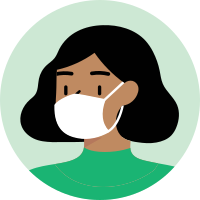Termites
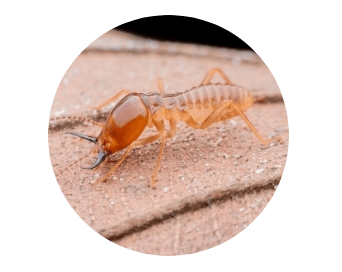
What do Termites look like?
Termites all belong to the phylum Arthropoda, the class Insecta, and the order Isoptera. There are over 2,000 different species of termites with over 40 species in the United States alone. Although they have distinct characteristics, most look similar. They typically measure between 1/4 and 1/2 of an inch long and have soft bodies with straight antennae. The queens and kings are larger, capable of reaching over one inch long. Colors range from white to light brown where worker termites often appear lighter while swarming termites darker. Flying termites, also called reproductives, have two pairs of prominent wings.
About Termites
As termites devour their way through the wood from the inside, it can be rather challenging to detect a termite infestation but there are some tell-tale signs that indicate their presence.
Termites are secretive pests and spotting them can prove to be very tricky. They can live undetected in hollow doors and wall voids for many years.
Your first clue to a termite problem may be small flying insects – known as termite Swarmers – flying near your windows and leaving behind their discarded wings. This phenomenon generally occurs in the springtime.
However, termites are active all year round, and as termite swarmers look very similar to flying ants, correct identification is critical as part of a professional customized solution. To actually tell if you have termites in your home, it is often easier to look for the early damage signs they can typically cause.
How Serious Are Termites?
A termite infestation and damage can be devastating to your home or property. Termites are often called the “silent destroyer” because they may be secretly hiding and thriving in your home or yard without any immediate signs of damage. All termites consume cellulose-based plant materials. Unfortunately, all homes, regardless of their construction type, can provide cellulose food for termite infestation.
Types of Termites
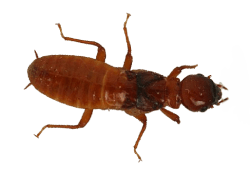
Dampwood Termite
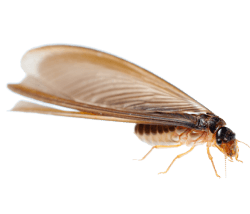
Drywood Termite
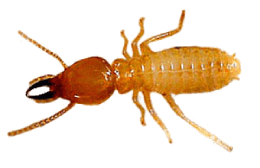
Formosan Termite
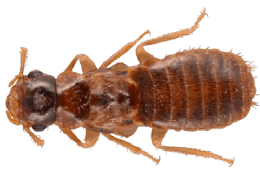
Subterranean Termite

Dampwood Termite
Facts, Identification & Control
Latin Name: Zootermopsis spp. and Neotermes spp.
Size:
Dampwood termites are much larger than the subterranean termites that are common across the country. Note: there are several species of damp-wood termites in the United States.
- Swarmers: The swarmers (winged termites) can be 25 mm long, including their wings.
- Soldiers: The soldiers can be as large as 20 mm.
- Immature: The immature termites can be as much as 20 mm long. The immature termites do the work in the colony.
Body:
- They have a large head with mandibles (pincers) on the front.
How Did I Get Dampwood Termites?
Wood that is water-damaged or rests directly on the ground is very likely to attract damp wood termites and some of the more likely things that damp wood termites are drawn to include stumps, lumber, fallen logs, and tree branches that are left in direct contact with the ground. In addition, damp wood termites may also infest rarely seen areas affected by roof leaks or cracked drainpipes.
How Serious Are Dampwood Termites?
Dampwood termites often weaken homes by hollowing out support beams. This can lead to costly repairs, causing a great deal of frustration. The silent and secretive nature of these pests makes damp wood termite activity difficult to recognize until it becomes severe.
To remain hidden, damp wood termites do not construct mud tubes, rather they cover up their entry holes with their own feces. Since wood infested by damp wood termites has a very high moisture content, the wood they infest can also be damaged by fungus. As one might expect, a damp wood termite infestation often indicates wood decay, as well as leaks that create excessive moisture in the home.
How Do I Get Rid of Dampwood Termites?
Continuous Treatment Plans
With us, you receive the most dependable termite control from an industry leader. Our Continuous Protection Plans use scientifically proven treatments designed for your home’s construction type.
Customized treatment
Based on the layout of your home and the degree of termite infestation, We will create a treatment plan tailored for your home.
Signs of Dampwood Termite Infestation
Damage
Dampwood termites do not usually have contact with the soil. They do not make tunnels like the subterranean termites
Wood that damp wood termites have damaged usually looks clean and smooth inside. They often eat across the grain, especially in wood that is decayed.
Frass
The damp wood termites sometimes use their fecal pellets to seal the galleries where they live from the outside air. If the wood is fairly dry, the fecal pellets may fall to the bottom of the gallery. If the wood is very damp, the fecal pellets may stick to the sides of the termite galleries.
Swarmers
Large winged swarmers, winged males and females, are produced for the purpose of mating and starting new colonies. These may be confused with winged ants, but the termites have straight antennae, four pairs of equal length wings, and a straight-sided body.
Behavior, Diet & Habits
Where do they live?
Dampwood termites get their name from the damp, sometimes decaying, wood that they use to locate their colonies. Dampwood termites do not typically nest in the soil. They will invade wood that is on the ground, especially if it is decaying.
Distribution range
Dampwood termites are common along the Pacific coast. They are considered an economic pest. There are also damp wood termites in the Southwest desert and in southern Florida.
Reproduction & Life Cycle
A pair of winged swarmers starts a colony of damp wood termites. They find a suitable piece of wood and make a chamber in it. They produce a few eggs in the first year. Colonies are usually small, but in ideal conditions, damp wood termite colonies can become large. There are no damp wood termite workers.
Prevention Tips
Remove moisture
Because moisture is critical to these termites, solving moisture problems is an important part of damp wood termite control. Plumbing problems, leaks in roof or siding, wood that is touching the ground, and even rainwater drainage are all examples of situations that may need to be addressed.
Replace damaged wood
After the moisture conditions have been corrected, the damaged wood can be replaced. It is sometimes necessary to use treated wood.

Drywood Termite
Facts, Identification & Control
Latin Name: Cryptotermes spp. and Incisitermes spp.
Appearance
Since the worker termites in these groups more or less look the same, the appearance of the reproductive caste (alates) and soldiers is important.
Wings
Alates, or swarmers, have two sets of wings. The front set of wings has a pattern of three or more heavy, well-pigmented veins in the outer part of that front wing. Also, swarmers shed their wings very quickly after swarming, so most all dead swarmer bodies do not have attached wings. This is a good characteristic to distinguish drywood termite swarms from subterranean termite swarms since subterranean swarmers will consist of dead swarmers with and without attached wings. Swarmers can be up to 12 mm long.
Body
Drywood termite soldiers have large mandibles (mouthparts) with teeth and their pronotum is as wide, or wider, than the head. Also, most drywood termite soldiers and workers are larger than the soldiers and workers in subterranean termite colonies.
How Did I Get Drywood Termites?
Drywood termites get all the moisture they need to survive and develop from humidity in the air and moisture they get from consuming the wood they eat. As a result, the drywood termites can survive without living in soil and do not construct their nests in the ground, but instead construct their nests in the dry, above-ground wood they infest. The pests enter homes through exposed wood or infested items like wooden furniture.
How Serious Are Drywood Termites?
Infestations can be limited to one area of the house or can be widespread. Damage is often extensive, as these pests will chew tunnels inside wooden beams or other wooden objects, weakening them from the inside. Home repairs for drywood termite damage may be costly and involve the use of house fumigation procedures.
How Do I Get Rid of Drywood Termites?
What We Do
Our Technician is trained to help manage termites. Since every home or property is different, our technician will design a unique program for your situation. Keeping termites out of your home is an ongoing process, not a one-time treatment.
Signs of a Drywood Termite Infestation
Swarms
When a drywood termite colony is mature, swarms of winged male and female reproductive insects are produced. These reproductive termites fly out of their colony to create new colonies after mating. Warm temperatures and heavy rains instigate swarms.
Frass
Drywood termites extract as much water as possible from the feces to conserve it. The result is very distinct fecal pellets called frass. They are hexagonal and all are a similar size of 1 mm long. The termites kick them out of their tunnel. The appearance of mounds of these pellets indicates activity. It is important to note that pellets can remain almost indefinitely from a dead colony and may mislead a homeowner that it is current activity. Contact a termite control professional to confirm the current activity.
Behavior, Diet & Habits
Where do they live?
Create colonies in wood and occasionally other cellulose material, with no connection to the ground necessary; often found in attic wood; need very little moisture.
Reproduction
Nymphs pass through four to seven instars before reaching adulthood; sexual forms eventually swarm to form new colonies.

Formosan Termite
Facts, Identification & Control
Latin Name: Coptotermes formosanus
Appearance
Formosan termites are social insects with three distinct forms (castes):
- the wingless or winged reproductives (alates)
- the protector soldiers
- the workers
Since Formosan termite workers look very much like workers of other termite groups, the soldiers and winged alates are the castes that are useful to provide correct identification.
Since the differentiation between Formosan termites and other termite groups is not easy, it is best to contact your pest management professional for help with providing an accurate identification.
The head of a Formosan termite soldier is oblong, whereas indigenous subterranean termites have rectangular heads. Formosan termite soldiers are also more aggressive when defending the nest than native subterranean termite soldiers.
When disturbed, the soldiers release a white liquid that is used for defense.
The alates, or swarmers, are yellowish-brown and about ½ inch long. Alates have a thick covering of small hairs on their otherwise transparent wings.
How Did I Get Formosan Termites?
Formosan termites come into homes via wood that touches the soil and by traveling from the ground to wood using their mud tubes. Common entrances include inside homes include openings created by unsealed joints or cracks. Aerial colonies may also infest roofs and other spots high above the ground. These pests flock to sources of wood, especially moist wood and wood located in places containing excessive moisture in the soil where water puddles instead of running off from around the home’s exterior.
How Serious Are Formosan Termites?
As one of the most destructive termite species in the United States, Formosan termites are a major concern for residents. They can multiply and destroy wood structures faster than other native subterranean species.
While the termite workers may not eat wood any quicker than other subterranean worker termites, they consume more wood in a given amount of time because their colony size typically is larger than other subterranean colonies. Formosan termite nests can contain millions of members and Infestations are hard to remove without professional pest control help.
How Do I Get Rid of Formosan Termites?
What We Do
Continuous Treatment Plans
With Us, you receive the most dependable termite control from an industry leader. Our Continuous Protection Plans use scientifically proven treatments designed for your home’s construction type, and every one of those treatments is backed by a money-back guarantee. We’ve been around for more than 100 years, so you can be confident we’ll be here when you need us.
Customized treatment
Based on the layout of your home and the degree of termite infestation, We will create a treatment plan tailored for your home.
Signs of Formosan Termite Infestation
Damage
Homeowners performing renovations may discover termite damage. As termites consume the wood they leave behind smooth-sided galleries. Damaged wood may also cause walls or other parts of the structure to sag.
Swarmers
In late spring or early summer, Formosan colonies may produce swarms of winged males and females called reproductives. They are about 15 mm long, including their wings. They can be differentiated from winged ants by their straight antennae, equal-length front, and hind wings, as well as their straight-sided waist.
Behavior, Diet & Habits
Where do they live?
Formosan termites are a type of subterranean termite that nests within the soil. They invade structures from the soil directly through the wood to ground contact or using mud tubes they construct up from the soil. Formosan termites also can construct a carton that helps retain moisture in the nest. This can allow them to build nests that do not require them to return to the soil like most subterranean termites.
What do they eat?
Like all termites, they consume cellulose material such as wood.
Reproduction & Life Cycle
Colonies contain a queen that can produce more than 1,000 eggs per day. New colonies are created when winged males and females are released from the colony and swarm. They mate and go on to found new colonies.

Subterranean Termite
Facts, Identification & Control
Latin Name: Reticulitermes spp., Coptotermes spp. and Heterotermes spp.
Appearance
Termites are broadly divided into three major termite groups:
- subterranean
- dry wood
- damp wood
If you are trying to classify a specific termite colony into a group, you need to look at the soldiers and the alates, the winged, unmated reproductive caste, because worker termites across groups tend to look the same. Also important is the appearance of the damaged wood they consume.
Identification factors for subterranean termites are:
- Alates (swarmers): Dark-brown to black in color, about ¼ to ½ inch long with two pairs of wings that are very close to being equal in length.
- Workers: No wings, about ¼ inch or less in length and cream-colored.
- Soldiers: No wings, large mandibles (jaws), termite colony defenders, are creamy-white in color, but their head is often brownish in color.
- The appearance of damaged wood: Since subterranean termites build their nests underground, damaged wood usually has an accumulation of soil or mud within the tunnels of the wood they are eating. Since subterranean termites only eat the softwood, damaged wood appears to be layered, the result of the workers not eating the hardwood portion. In addition, subterranean termites feed “with the grain” rather than across the grain, as do drywood termites.
- Location of the nest: As their group name suggests, the nest is usually found below ground. Nests may be found above ground, but only when sufficient moisture conditions are available to support the above-ground nest and the colony is old and well established.
How Did I Get Subterranean Termites?
These pests live in the soil beneath and around homes and often enter through wood that touches the ground or by constructing mud tubes from the ground to the wood they infest. Cracks in concrete walls and foundations made of hollow blocks are also paths these insects could take to infest a house.
How Serious Are Subterranean Termites?
As the most common type of termite nationwide, subterranean termites cause billions of dollars in structural damage each year. They also eat books, other paper products, cellulose-based products, and a variety of other plant-based goods.
Some colonies have more than one egg-laying female, so subterranean termite nests can grow quickly and contain hundreds and sometimes thousands of members. Since the pests can often infest homes for years undetected, responding to early warning signs is key to preventing serious damage. The most commonly observed warning signs are the presence of winged swarmers, mud tubes, and evidence of damaged wood.
How Do I Get Rid of Subterranean Termites?
What We Do
Continuous Treatment Plans
With Us, you receive the most dependable termite control from an industry leader. Our Continuous Protection Plans use scientifically proven treatments designed for your home’s construction type, and every one of those treatments is backed by a money-back guarantee. We’ve been around for more than 100 years, so you can be confident we’ll be here when you need us.
Customized treatment
Based on the layout of your home and the degree of termite infestation, We will create a treatment plan tailored for your home.
Signs of a Subterranean Termite Infestation
Swarmers
A subterranean termite infestation begins when warm temperatures and heavy rainfall trigger an established colony to send out a swarm of winged termites. Swarms consist of winged reproductive males and females. Subterranean termite colonies are usually active for three to five years before winged reproductives appear.
Winged, reproductive termites are frequently mistaken for flying ants, but are smaller than ants and have straight, rather than bent, antennae. Termite swarmers have four wings that are all the same size. Ant swarmers have two large wings in front and two smaller wings behind.
Piles of Wings
After mating, swarmer termites land and shed their wings, leaving them in piles that resemble fish scales. If there are piles of wings on the windowsills of your home, check to see if they are all the same size. They could be termite wings especially if they are all the same size.
Damaged Wood
Subterranean termites create a distinctive honeycomb pattern in damaged wood, forming tunnels inside the softer springwood and leaving the external grain intact.
Behavior, Diet & Habit
Where do they live?
Live in colonies underground, from which they build tunnels in search of food; able to reach food above the ground level by building mud tubes; dependent on moisture for survival.
What do they eat?
Diet consists of wood and other cellulose material.
Reproduction
Different rates of growth from egg stage to adult, depending on individual species; one primary queen per colony, which can lay tens of thousands of eggs in its lifetime, but eggs also can be laid by supplementary reproductives in an established colony.
Let's Work Together!
Get rid of those Pests!


